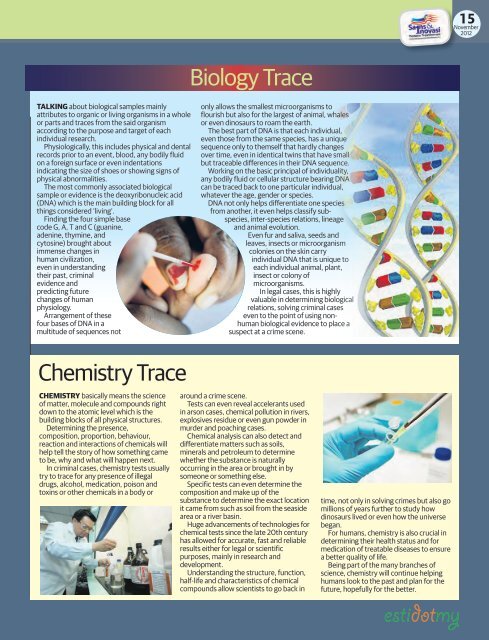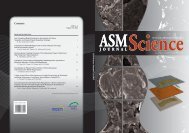Dunia Forensik - Akademi Sains Malaysia
Dunia Forensik - Akademi Sains Malaysia
Dunia Forensik - Akademi Sains Malaysia
- No tags were found...
Create successful ePaper yourself
Turn your PDF publications into a flip-book with our unique Google optimized e-Paper software.
15November2012Biology traceTALKING about biological samples mainlyattributes to organic or living organisms in a wholeor parts and traces from the said organismaccording to the purpose and target of eachindividual research.Physiologically, this includes physical and dentalrecords prior to an event, blood, any bodily fluidon a foreign surface or even indentationsindicating the size of shoes or showing signs ofphysical abnormalities.The most commonly associated biologicalsample or evidence is the deoxyribonucleic acid(DNA) which is the main building block for allthings considered ‘living’.Finding the four simple basecode G, A, T and C (guanine,adenine, thymine, andcytosine) brought aboutimmense changes inhuman civilization,even in understandingtheir past, criminalevidence andpredicting futurechanges of humanphysiology.Arrangement of thesefour bases of DNA in amultitude of sequences notonly allows the smallest microorganisms toflourish but also for the largest of animal, whalesor even dinosaurs to roam the earth.The best part of DNA is that each individual,even those from the same species, has a uniquesequence only to themself that hardly changesover time, even in identical twins that have smallbut traceable differences in their DNA sequence.Working on the basic principal of individuality,any bodily fluid or cellular structure bearing DNAcan be traced back to one particular individual,whatever the age, gender or species.DNA not only helps differentiate one speciesfrom another, it even helps classify subspecies,inter-species relations, lineageand animal evolution.Even fur and saliva, seeds andleaves, insects or microorganismcolonies on the skin carryindividual DNA that is unique toeach individual animal, plant,insect or colony ofmicroorganisms.In legal cases, this is highlyvaluable in determining biologicalrelations, solving criminal caseseven to the point of using nonhumanbiological evidence to place asuspect at a crime scene.Chemistry traceCHEMISTRY basically means the scienceof matter, molecule and compounds rightdown to the atomic level which is thebuilding blocks of all physical structures.Determining the presence,composition, proportion, behaviour,reaction and interactions of chemicals willhelp tell the story of how something cameto be, why and what will happen next.In criminal cases, chemistry tests usuallytry to trace for any presence of illegaldrugs, alcohol, medication, poison andtoxins or other chemicals in a body oraround a crime scene.Tests can even reveal accelerants usedin arson cases, chemical pollution in rivers,explosives residue or even gun powder inmurder and poaching cases.Chemical analysis can also detect anddifferentiate matters such as soils,minerals and petroleum to determinewhether the substance is naturallyoccurring in the area or brought in bysomeone or something else.Specific tests can even determine thecomposition and make up of thesubstance to determine the exact locationit came from such as soil from the seasidearea or a river basin.Huge advancements of technologies forchemical tests since the late 20th centuryhas allowed for accurate, fast and reliableresults either for legal or scientificpurposes, mainly in research anddevelopment.Understanding the structure, function,half-life and characteristics of chemicalcompounds allow scientists to go back intime, not only in solving crimes but also gomillions of years further to study howdinosaurs lived or even how the universebegan.For humans, chemistry is also crucial indetermining their health status and formedication of treatable diseases to ensurea better quality of life.Being part of the many branches ofscience, chemistry will continue helpinghumans look to the past and plan for thefuture, hopefully for the better.

















